Contemporary Church History Quarterly
Volume 20, Number 1 (March 2014)
Review of Clifford Green and Guy Carter, eds., Interpreting Bonhoeffer, Historical Perspectives/Emerging Issues (Minneapolis: Fortress Press, 2013), Pp. xvi + 258, ISBN 978-4514-6541-9.
By John S. Conway, University of British Columbia
The time has come, the editors said, for a synopsis of Bonhoeffer’s theology and witness. So Clifford Green and Guy Carter invited an international gathering of theologians, translators and historians for a conference at the Union Theological Seminary in New York in November 2011. The papers from that meeting have now been published in this book. But since they were presumably prepared in advance, it is not clear how much resulted from this meeting. The reader is left to make his or her own synopsis.
 The tone is of course laudatory, rather than critical. But at least these papers help to set the boundaries within which Bonhoeffer scholarship can flourish today, and thus exclude some of the more exaggerated theories. For example, in recent years, Bonhoeffer has been characterized as a revolutionary, an assassin and an American Evangelical. None of these authors was invited. On the other hand, it is also clear that the theologians and the historians are not always talking on the same wave-length. The latter’s approach is empirical, concrete and historical, whereas the former seem often to engage in highly theoretical, even metaphysical interpretations, which rarely touch down on the solid earth of Nazi Germany. So this book should help to encourage some cross-fertilization in the debates about Bonhoeffer’s legacy.
The tone is of course laudatory, rather than critical. But at least these papers help to set the boundaries within which Bonhoeffer scholarship can flourish today, and thus exclude some of the more exaggerated theories. For example, in recent years, Bonhoeffer has been characterized as a revolutionary, an assassin and an American Evangelical. None of these authors was invited. On the other hand, it is also clear that the theologians and the historians are not always talking on the same wave-length. The latter’s approach is empirical, concrete and historical, whereas the former seem often to engage in highly theoretical, even metaphysical interpretations, which rarely touch down on the solid earth of Nazi Germany. So this book should help to encourage some cross-fertilization in the debates about Bonhoeffer’s legacy.
Victoria Barnett leads off for the historians, along with three other members of our CCHQ team. She has been the general editor of the English translations of the sixteen volumes of Bonhoeffer’s papers, but still feels that this is only a work-in-progress. And just because the epoch in which he lived is gone, so the challenge is to try and understand the church and faith which shaped him and his students. In the thousands of pages which survived–his biographer Bethge collected everything–it is easy to get lost in the forest and not to see the trees. His life and work remain fragmentary and unfinished. And, as he himself admitted, he was never completely clear about his motives. Barnett rightly states that, contrary to his later fame, Bonhoeffer was a marginal figure in the German Church and the Resistance Movement. For the most part, as he himself admitted, he was amongst those who were “silent witnesses to evil deeds.” His life was cruelly cut short at an early age. His theological enterprise was barely begun. Yet his contribution–at a time when European Christianity suffered drastic blows–was an authentic witness to a world come of age.
Doris Bergen takes up the question of why the churches made so few protests against the Nazis’ crimes. Their silence in face of the Nazi persecutions and outrages has been a charge frequently leveled against Christianity. The question, she thinks, is inadequate. It is not the silence, but the noisy and enthusiastic support for the Nazi regime which concerns her most. Much more pertinent would be to question why the churches so readily backed the Nazi state. Why did they engage in pro-Nazi ceremonies, lend their religious support to Hitler’s wars of aggression, indulge in antisemitic propaganda, and even expel Jewish-Christian members from their parishes? She gives numerous and shocking examples of how the majority of churchmen, both Catholic and Protestant, subordinated or distorted Christian teachings in order to provide ringing and voluntary endorsements as loyal Germans, and genuine Nazis. This was the very opposite of silence. She clearly does not have much time for those who were later to argue that churchmen were intimidated by the ruthless police state tactics of the regime, and were fearful lest they be taken off to be imprisoned in one or other concentration camp. As she rightly points out, silence or martyrdom were not the hallmarks of the majority of German Christians, though all honour is due to those who chose this latter path. But she might have considered more fully the principal reason for what seems to us now as widespread apostasy. In my view, the root cause lies in the churches’ shattering loss of credibility in the years after 1918 when their strident preaching of an imminent German victory with God’s blessing was proved false, and their proclamation of God’s beneficence had to come to terms with the millions of corpses lying in Flanders Fields. In the subsequent years, the attempt to regain the allegiance of those they had so grievously misled was their principal concern. Enthusiastic support for a popular political movement seemed to be the avenue to make the church relevant again. For Catholics, who had for so long been regarded as second-class citizens, the opportunity to upgrade their status by joining the Nazi bandwagon seemed to secure their institutional position in the wider society. Protestants too were eager to celebrate their national loyalties and to swallow their reservations about the tactics employed by their new rulers. Their complicity in the regime’s crimes cannot be doubted, even if many of them deluded themselves as to its true nature or intentions. The silence of the churches after 1945 was all the more obvious when, for the most part, they showed no remorse or repentance.
Bob Ericksen echoes the same themes in his short chapter, in which he too strongly criticizes the readiness of so many church people to concur with Nazism, including the majority of the Confessing Church, at least on national grounds. Bonhoeffer was one of the very few pastors of his generation who differed from the majority. This only led to his isolation both during his life, and even more so afterwards. For many years after 1945 the majority of nationally-minded churchmen took exception to his political or to his theological views, or to both. It was at least twenty years before the impact of his “new theology” and the prodigious efforts of his biographer, Eberhard Bethge, paid off. Ericksen has more recently written extensively about the complicity of both the pastors and the professors in serving the Nazi regime, mainly for nationalistic reasons. In this essay he correctly criticizes the churches’ readiness to praise Hitler’s brutal imposition of repressive measures, especially against the Jews, for whom churchmen showed relatively little or no empathy, and all too readily accepted the Nazi propaganda that the Jews were a threat to German values. Their predisposition to anti-Judaic theological biases rendered them, even Bonhoeffer, incapable of changing to a much more positive evaluation of their Jewish heritage.
Matthew Hockenos gives an excellent summary of how the Protestant churches eventually came to terms with this deficient legacy. He rightly questions the extent to which Bonhoeffer himself changed his theology about the Jews, since we lack any substantial evidence after his very tradition-bound statement of supersessionist theology from 1933. Hockenos points out that the leaders of the Evangelical Church after 1945 were all survivors of the Confessing Church struggle, and still politically and theologically nationalistic. When it came to addressing the church’ share of responsibility for the policies of the Third Reich, these leaders “demonstrated more trepidation than courage, more equivocation than clarity, and more obstruction than determination.” Most of them were shocked by Bonhoeffer’s readiness to take part in the conspiracy to overthrow Hitler and regarded him as a national traitor not a Christian martyr. They stressed the post-war indignities and sufferings of their own people at the hands of the occupying powers, rather than the far greater sufferings their countrymen had imposed on so many other nations and peoples. It took years before Bonhoeffer’s reforming ideas could take hold. Similarly, years were to pass before a new climate of repentance for Christian prejudice against the Jews could emerge. Hockenos provides a notable if brief description of the slow and often reluctant process of “metanoia” in the Evangelical Churches on the subject of attitudes towards the Jews, and contrasts this with the much more vibrant contributions of such Catholics as John Oesterreicher and Gertrud Luckner, whose pioneer efforts were to find fruition in the Second Vatican Council. But thanks to Bonhoeffer’s biographer, Eberhard Bethge, the same route was finally taken by the German Protestants too.
Keith Clements’ fine contribution focuses on Bonhoeffer’s postwar reception in Britain, which was much more friendly and sympathetic than in his homeland. This was largely due to the friendships he had established with the ecumenically-minded community during his earlier visits to England. Principally it was the Bishop of Chichester, George Bell, with whom Bonhoeffer had collaborated in the Life and Work Movement, and who warmly welcomed him on his arrival to look after the German-speaking churches in London. Bell found Bonhoeffer a most valuable source of information about the German Evangelical Church, and resolutely backed the Confessing Church in its struggle to block the Nazi plans. It was also Bell, who most courageously defied public opinion and organized the first memorial service for Bonhoeffer–a dead German–in a large London church in July 1945. So too Bonhoeffer found an ally in Joe Oldham, one of the chief architects of the future World Council of Churches, and in Ronald Gregor Smith, the Editor of the Student Christian Movement Press, which was the first to publish Bonhoeffer’s Letters and Papers from Prison in English translation. Its impact caused sensational reactions in the early 1950s. All of these men had a deep sense of the crisis facing Western Civilization, and the need for new visions, not just for the church, but for the world and humanity. Bonhoeffer’s message from his prison cell exactly matched their hopes, and gave a pragmatic concreteness to their witness in those years.
Other essays in this collection explore the impact of Bonhoeffer’s theology in such far distant societies as Japan and Brazil, thus giving a world-wide dimension to his legacy. Of course, this global appearance of his ideas and life-story owed much to the successes of his translators, especially into English. Several papers in this book show how this task was undertaken, and how the translators had to wrestle with Bonhoeffer’s cultivated, upper-class, but somewhat dated German, and to find up-to-date and more colloquial expressions in English for his much wider audiences. A very good instance of their dilemmas comes in trying to translate the well-known poem Christen und Heiden. They were also perplexed by Bonhoeffer’s continual use of masculine pronouns for “God” or “Man”, and wondered how appropriate it would be to turn these gendered expressions into some more modern form of inclusive language. It was a delicate course to steer between the Scylla of Bonhoeffer the proto-feminist and the Charybdis of Bonhoeffer the hopeless chauvinist.
The theologians’ contributions focus very largely on Bonhoeffer’s ideas about “public ministry” and are drawn from close studies of his Ethics. As the epoch of European-centered Christianity is increasingly replaced by global diversification, and as his homeland Germany, like other parts of historic Christian Europe, becomes more and more pluralistic in its religious allegiances, so Bonhoeffer’s insights will undoubtedly continue to be of value in guiding us forward in fashioning new forms of discipleship for the years ahead.

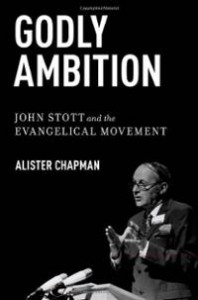 John Stott was born in 1921 in a well-to-do professional family and, as was the custom, went to one of England’s most prestigious private (i.e. “public”) schools, Rugby, where his talents led to his appointment as Head Boy. At the age of seventeen, he had a classic evangelical conversion experience and invited Jesus Christ into his life. This was largely due to the influence of an itinerant Anglican clergyman named Eric Nash, whose mission it was to attract young public school leaders and lead them to a life of Christian witness and service . Nash remained Stott’s mentor for many years and undoubtedly encouraged him to seek ordination as a Church of England priest. This decision was to be a great disappointment to Stott’s family, as was (even more so) his resolve not to be conscripted to do military service at the very moment when the Second World War broke out in 1939. Stott took advantage of the loop-hole which allowed students in training for the ministry to be exempt from military service. He was thus one of the few young men taking his war-time undergraduate degree at Trinity College, Cambridge, after which he moved on to the nearby theological college, Ridley Hall, which resolutely maintained the evangelical tradition of those martyrs burnt at the stake by Queen Mary four centuries earlier.
John Stott was born in 1921 in a well-to-do professional family and, as was the custom, went to one of England’s most prestigious private (i.e. “public”) schools, Rugby, where his talents led to his appointment as Head Boy. At the age of seventeen, he had a classic evangelical conversion experience and invited Jesus Christ into his life. This was largely due to the influence of an itinerant Anglican clergyman named Eric Nash, whose mission it was to attract young public school leaders and lead them to a life of Christian witness and service . Nash remained Stott’s mentor for many years and undoubtedly encouraged him to seek ordination as a Church of England priest. This decision was to be a great disappointment to Stott’s family, as was (even more so) his resolve not to be conscripted to do military service at the very moment when the Second World War broke out in 1939. Stott took advantage of the loop-hole which allowed students in training for the ministry to be exempt from military service. He was thus one of the few young men taking his war-time undergraduate degree at Trinity College, Cambridge, after which he moved on to the nearby theological college, Ridley Hall, which resolutely maintained the evangelical tradition of those martyrs burnt at the stake by Queen Mary four centuries earlier.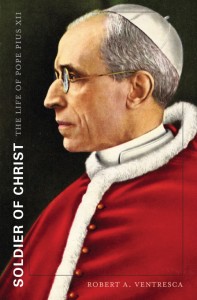 Born into the “black nobility” of Roman society, Pacelli lived a privileged life that even included a rare dispensation that enabled him to avoid the rigors of seminary life for the flexibility of home with his family. Pacelli was also not ordained with his classmates, but during a separate Mass in a private chapel. Despite such an uncommon priestly formation, Ventresca concludes that amid the changes “brought about by the fall of papal Rome in 1870, it is difficult to say whether there was anything typical about Pacelli’s clerical training in the closing decades of the nineteenth century” (p. 36). Yet, Ventresca reveals that Pacelli was exceptional. Even prior to earning a doctorate in canon law in 1904, Pacelli caught the attention of Pietro Gasparri, the secretary of the Sacred Congregation for Extraordinary Ecclesiastical Affairs, who soon became a patron and ensured a smooth transition for the young priest into Vatican bureaucracy. By 1914, the talented Pacelli had replaced Gasparri when the latter rose to become secretary of state. Three years later, Pacelli himself rose in the ranks to become papal nuncio to Bavaria. Prior to his departure for Germany, Pacelli was consecrated archbishop of Sardis by Pope Benedict XV himself.
Born into the “black nobility” of Roman society, Pacelli lived a privileged life that even included a rare dispensation that enabled him to avoid the rigors of seminary life for the flexibility of home with his family. Pacelli was also not ordained with his classmates, but during a separate Mass in a private chapel. Despite such an uncommon priestly formation, Ventresca concludes that amid the changes “brought about by the fall of papal Rome in 1870, it is difficult to say whether there was anything typical about Pacelli’s clerical training in the closing decades of the nineteenth century” (p. 36). Yet, Ventresca reveals that Pacelli was exceptional. Even prior to earning a doctorate in canon law in 1904, Pacelli caught the attention of Pietro Gasparri, the secretary of the Sacred Congregation for Extraordinary Ecclesiastical Affairs, who soon became a patron and ensured a smooth transition for the young priest into Vatican bureaucracy. By 1914, the talented Pacelli had replaced Gasparri when the latter rose to become secretary of state. Three years later, Pacelli himself rose in the ranks to become papal nuncio to Bavaria. Prior to his departure for Germany, Pacelli was consecrated archbishop of Sardis by Pope Benedict XV himself.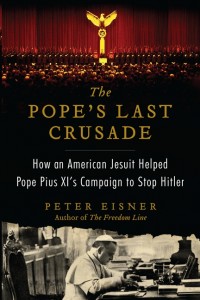 Briefly the story is as follows. Pope Pius XI (Achille Ratti) who reigned from 1922 to 1939 was increasingly alarmed and dismayed by the rise of Nazism and its flagrant and sustained attacks against both the Catholic Church and the Jews. Already in 1937, Pope Pius, after consulting the German bishops, had issued a vigorous protest in the Encyclical “Mit Brennennder Sorge”. But the results were disappointing. Hitler merely stepped up his persecution of the church, and encouraged his associates to be even more virulent in their campaigning against the Jews. But by 1938 the Pope had determined to protest again, specifically against the violent extremism in the Nazis’ racial and anti-Semitic ideology. By chance the Pope had come across a book written by LaFarge entitled Interracial Justice, which described the plight of blacks in the United States, and pleaded for the church to take a lead in combatting racism in that country. The parallels between racism in America and the dangers of anti-Semitism in Europe were easy to see.
Briefly the story is as follows. Pope Pius XI (Achille Ratti) who reigned from 1922 to 1939 was increasingly alarmed and dismayed by the rise of Nazism and its flagrant and sustained attacks against both the Catholic Church and the Jews. Already in 1937, Pope Pius, after consulting the German bishops, had issued a vigorous protest in the Encyclical “Mit Brennennder Sorge”. But the results were disappointing. Hitler merely stepped up his persecution of the church, and encouraged his associates to be even more virulent in their campaigning against the Jews. But by 1938 the Pope had determined to protest again, specifically against the violent extremism in the Nazis’ racial and anti-Semitic ideology. By chance the Pope had come across a book written by LaFarge entitled Interracial Justice, which described the plight of blacks in the United States, and pleaded for the church to take a lead in combatting racism in that country. The parallels between racism in America and the dangers of anti-Semitism in Europe were easy to see.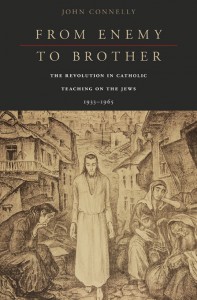
 Unlike most of the studies of postwar Germany that focus on the origins of the Cold War and high stakes political maneuvering of the Allies, Schroeder takes a bottom-up approach that illuminates the less conspicuous reconciliation work of German groups such as the Association of the Victim of Nazism (VVN) and religiously-affiliated international groups such as International Fellowship of Reconciliation (IFOR), Moral Re-Armament (MRA), Pax Chrisiti, the International Council of Christians and Jews (ICCJ), and the World Council of Churches (WCC). His study compares and contrasts reconciliation, defined as “the establishment of peaceful – or at least non-hostile – relations between former enemies” in the four zones of occupation in the immediate postwar years and in East and West Germany after 1949.
Unlike most of the studies of postwar Germany that focus on the origins of the Cold War and high stakes political maneuvering of the Allies, Schroeder takes a bottom-up approach that illuminates the less conspicuous reconciliation work of German groups such as the Association of the Victim of Nazism (VVN) and religiously-affiliated international groups such as International Fellowship of Reconciliation (IFOR), Moral Re-Armament (MRA), Pax Chrisiti, the International Council of Christians and Jews (ICCJ), and the World Council of Churches (WCC). His study compares and contrasts reconciliation, defined as “the establishment of peaceful – or at least non-hostile – relations between former enemies” in the four zones of occupation in the immediate postwar years and in East and West Germany after 1949.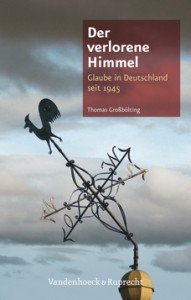 Thomas Grossbölting, who teaches at the University of Münster, poses these questions and puts them in the context of faith, church and religion after the catastrophe of National Socialism in Germany. This well researched study can be seen as the first up-to-date history of religion in the Federal Republic of Germany. His basic thesis is clear and hardly surprising. Anyone examining how and what Germans have believed in the past fifty years has to take note of a striking decline in the significance of religious consciousness. Although, in recent years, some observers have claimed that there has been a so-called religious revival, in fact anyone taking a longer view over the past five or six decades must conclude that a far-reaching secularization has taken place. The very idea of Heaven has been lost. As the author crucially points out in his introduction: “A Christian Germany no longer exists”. On the other hand, the elements of faith, church and religion have not disappeared from daily life in Germany. Rather they have been thinned out, pushed to the edge of society, and in many people’s lives they are completely or largely absent.
Thomas Grossbölting, who teaches at the University of Münster, poses these questions and puts them in the context of faith, church and religion after the catastrophe of National Socialism in Germany. This well researched study can be seen as the first up-to-date history of religion in the Federal Republic of Germany. His basic thesis is clear and hardly surprising. Anyone examining how and what Germans have believed in the past fifty years has to take note of a striking decline in the significance of religious consciousness. Although, in recent years, some observers have claimed that there has been a so-called religious revival, in fact anyone taking a longer view over the past five or six decades must conclude that a far-reaching secularization has taken place. The very idea of Heaven has been lost. As the author crucially points out in his introduction: “A Christian Germany no longer exists”. On the other hand, the elements of faith, church and religion have not disappeared from daily life in Germany. Rather they have been thinned out, pushed to the edge of society, and in many people’s lives they are completely or largely absent.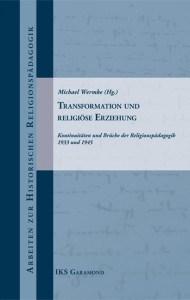 Two of the chapters are biographical studies of individual religious educators or professors at teacher training institutions. Thomas Martin Schneider’s “Die Umbrüche 1933 und 1945 und die Religionspädagogik” takes up the story of Georg Maus, a religion teacher at an Oberschule in Idar- Oberstein. Maus, who was associated with the Confessing Church, was accused of undermining the war effort because he failed to properly manage a class discussion of Jesus’ command to love one’s enemies. He received a two-year sentence and died while being transported to Dachau. Schneider contrasts Maus’ story with that of Reinhold Krause, also an educator, but most famous for his address to members of the German Christian Movement at the Berlin Sport Palace Rally in 1933. Schneider finds that Krause both appropriated and violated aspects of liberal Protestant thought. The cases of Maus and Krause, Schneider argues, call into question both the “conservative decadence model” that blames liberal Protestant theology for Nazi conceptions of Christianity and the “progress- optimistic model” that exonerates it of all charges. Theological orientations, including diverse political theologies in the twentieth century, cannot be judged apart from their historical contexts. Likewise, one should not reduce contemporary religious education to the narrow range of options that were present in the Third Reich, nor should one assume that those options will have the same value in all historical settings.
Two of the chapters are biographical studies of individual religious educators or professors at teacher training institutions. Thomas Martin Schneider’s “Die Umbrüche 1933 und 1945 und die Religionspädagogik” takes up the story of Georg Maus, a religion teacher at an Oberschule in Idar- Oberstein. Maus, who was associated with the Confessing Church, was accused of undermining the war effort because he failed to properly manage a class discussion of Jesus’ command to love one’s enemies. He received a two-year sentence and died while being transported to Dachau. Schneider contrasts Maus’ story with that of Reinhold Krause, also an educator, but most famous for his address to members of the German Christian Movement at the Berlin Sport Palace Rally in 1933. Schneider finds that Krause both appropriated and violated aspects of liberal Protestant thought. The cases of Maus and Krause, Schneider argues, call into question both the “conservative decadence model” that blames liberal Protestant theology for Nazi conceptions of Christianity and the “progress- optimistic model” that exonerates it of all charges. Theological orientations, including diverse political theologies in the twentieth century, cannot be judged apart from their historical contexts. Likewise, one should not reduce contemporary religious education to the narrow range of options that were present in the Third Reich, nor should one assume that those options will have the same value in all historical settings.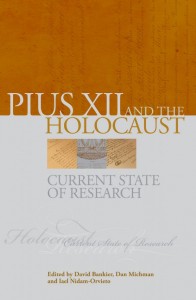 The workshop was a further attempt to mend frayed relations. Yad Vashem and the Reverend Roberto Spataro (acting “on behalf of the Nuncio”) each chose five scholars for the workshop. The latter: Andrea Tornielli, Matteo Napolitano, Grazia Loparco, Jean-Dominique Durand, and Thomas Brechenmacher; the former: Paul O’Shea, Michael Phayer, Susan Zuccotti, Sergio Minerbi, and Dina Porat. Summing up at the end, the Reverend Spataro commented: “we met in an atmosphere of confidence, trust and mutual respect.”
The workshop was a further attempt to mend frayed relations. Yad Vashem and the Reverend Roberto Spataro (acting “on behalf of the Nuncio”) each chose five scholars for the workshop. The latter: Andrea Tornielli, Matteo Napolitano, Grazia Loparco, Jean-Dominique Durand, and Thomas Brechenmacher; the former: Paul O’Shea, Michael Phayer, Susan Zuccotti, Sergio Minerbi, and Dina Porat. Summing up at the end, the Reverend Spataro commented: “we met in an atmosphere of confidence, trust and mutual respect.”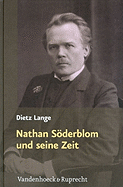 A new biography has recently been published in Germany of Nathan Söderblom, the most prominent Protestant church leader in the decade of the 1920s. The author, Dietz Lange, is the emeritus professor of Systematic Theology in Göttingen, and in this laudatory but leisurely account of Söderblom’s career, the emphasis is placed on the evolution of Söderblom’s intellectual ideas and his relations with other scholars and theologians of his time. Lange supplements but does not supplant the standard biography in English, written nearly half a century ago by Bengt Sundkler, which concentrated on Söderblom’s main claims to fame, his championships of the peace endeavours during the first world war, and his leadership of the ecumenical movement in the aftermath.
A new biography has recently been published in Germany of Nathan Söderblom, the most prominent Protestant church leader in the decade of the 1920s. The author, Dietz Lange, is the emeritus professor of Systematic Theology in Göttingen, and in this laudatory but leisurely account of Söderblom’s career, the emphasis is placed on the evolution of Söderblom’s intellectual ideas and his relations with other scholars and theologians of his time. Lange supplements but does not supplant the standard biography in English, written nearly half a century ago by Bengt Sundkler, which concentrated on Söderblom’s main claims to fame, his championships of the peace endeavours during the first world war, and his leadership of the ecumenical movement in the aftermath.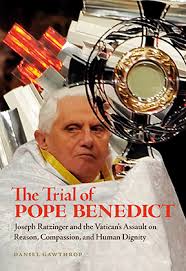 Writing with considerable journalistic flair, but of course without any Vatican official documentation, Gawthrop presents us with a highly critical account of Ratzinger’s career. To be sure, he allows that, during the Council’s sessions, Ratzinger, then a theological advisor to one of the German Cardinals, supported many of the reformist ideas. But only a few years later, while he was teaching at Germany’s most prestigious university of Tübingen, he was deeply offended by the virulent student radicalism embracing a “Marxist messianism”. As a result he turned away from his colleagues such as Hans Kung and other progressive theologians. Shortly afterwards he retreated to the rural backwater of Regensburg in his native Bavaria, and began to prepare his theological counter-offensive to Vatican II.
Writing with considerable journalistic flair, but of course without any Vatican official documentation, Gawthrop presents us with a highly critical account of Ratzinger’s career. To be sure, he allows that, during the Council’s sessions, Ratzinger, then a theological advisor to one of the German Cardinals, supported many of the reformist ideas. But only a few years later, while he was teaching at Germany’s most prestigious university of Tübingen, he was deeply offended by the virulent student radicalism embracing a “Marxist messianism”. As a result he turned away from his colleagues such as Hans Kung and other progressive theologians. Shortly afterwards he retreated to the rural backwater of Regensburg in his native Bavaria, and began to prepare his theological counter-offensive to Vatican II. The work is divided into four “complexes” which Linden has assigned to the years 1907-1910, 1920, 1926-1930 and 1933-1936 respectively. According to the author, these times saw greater changes in inter-pastoral relationships than did the political watersheds of 1914, 1918 and 1933. Linden explains the beginning of the time period considered by referring to comprehensive changes in the churchly life of Osnabrück, especially the increasing passivity of the laymen and therefore the increasing importance of the pastor in the parish. By contrast, why the time period ends in 1936 is not explained. According to the attached short biographies, there was no significant change to church staffing in that year with the exception of Rudolf Detering, who went to Goslar for a better position. However, Linden states at the end that the intensity of the relationships had decreased since 1935, with increasing isolation leading to fewer opportunities for networking or cooperation (p. 793).
The work is divided into four “complexes” which Linden has assigned to the years 1907-1910, 1920, 1926-1930 and 1933-1936 respectively. According to the author, these times saw greater changes in inter-pastoral relationships than did the political watersheds of 1914, 1918 and 1933. Linden explains the beginning of the time period considered by referring to comprehensive changes in the churchly life of Osnabrück, especially the increasing passivity of the laymen and therefore the increasing importance of the pastor in the parish. By contrast, why the time period ends in 1936 is not explained. According to the attached short biographies, there was no significant change to church staffing in that year with the exception of Rudolf Detering, who went to Goslar for a better position. However, Linden states at the end that the intensity of the relationships had decreased since 1935, with increasing isolation leading to fewer opportunities for networking or cooperation (p. 793).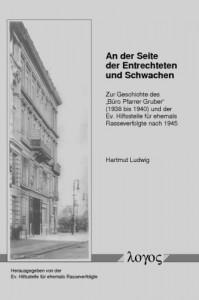 The record of the German Evangelical Churches, including the Confessing Church of Karl Barth and Dietrich Bonhoeffer, in failing to mobilize opposition to the Nazis’ violent attacks on the Jews is a shameful one. It has been excellently researched in the recent book by Robert Ericksen, Complicity in the Holocaust: Churches and Universities in Nazi Germany. In the post-1945 period, when the horrifying facts of the Holocaust were revealed, the Church was overwhelmed with a deep feeling of guilty shame. The subject was to be avoided. It took many years before the details emerged of one of the more significant, if belated, efforts in the Protestant ranks, namely the establishment in 1938 of an office to assist the persecuted Protestant victims of Nazi oppression. Hartmut Ludwig’s contribution in retelling the story of the “Büro Grüber” is therefore much to be welcomed.
The record of the German Evangelical Churches, including the Confessing Church of Karl Barth and Dietrich Bonhoeffer, in failing to mobilize opposition to the Nazis’ violent attacks on the Jews is a shameful one. It has been excellently researched in the recent book by Robert Ericksen, Complicity in the Holocaust: Churches and Universities in Nazi Germany. In the post-1945 period, when the horrifying facts of the Holocaust were revealed, the Church was overwhelmed with a deep feeling of guilty shame. The subject was to be avoided. It took many years before the details emerged of one of the more significant, if belated, efforts in the Protestant ranks, namely the establishment in 1938 of an office to assist the persecuted Protestant victims of Nazi oppression. Hartmut Ludwig’s contribution in retelling the story of the “Büro Grüber” is therefore much to be welcomed.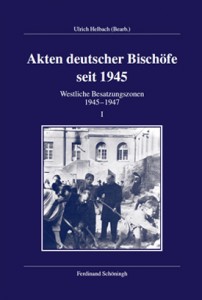 The research behind these editions is tremendous. These three tomes collectively occupy approximately 2400 pages and bring together nearly 725 documents from more than fifty archives, including more than 40 church archives in Germany, German state archives, private papers and two archives from the United States. Before making their final selections, the archivists and research teams assisting them had to wade through thousands of folders of documents and pre-select more than two thousand documents for possible inclusion. The documents themselves include correspondence and addresses not only in German but also in English, French and Latin, as the bishops were in regular correspondence with occupation officials from the Western Allies and the Vatican. Fortunately, the two editors, Dr. Ulrich Helbach, the director of the archive for the archdiocese of Cologne, and Dr. Annette Mertens of the Kommission für Zeitgeschichte, ensured that adept translations into German were provided for the foreign documents.
The research behind these editions is tremendous. These three tomes collectively occupy approximately 2400 pages and bring together nearly 725 documents from more than fifty archives, including more than 40 church archives in Germany, German state archives, private papers and two archives from the United States. Before making their final selections, the archivists and research teams assisting them had to wade through thousands of folders of documents and pre-select more than two thousand documents for possible inclusion. The documents themselves include correspondence and addresses not only in German but also in English, French and Latin, as the bishops were in regular correspondence with occupation officials from the Western Allies and the Vatican. Fortunately, the two editors, Dr. Ulrich Helbach, the director of the archive for the archdiocese of Cologne, and Dr. Annette Mertens of the Kommission für Zeitgeschichte, ensured that adept translations into German were provided for the foreign documents.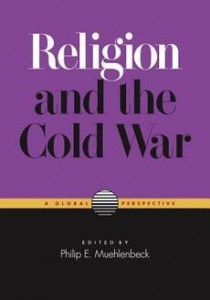 Three essays from this collection that focus on the Catholic and Protestant churches in Europe and America will be of particular interest to CCHQ readers. In his essay, “The Western Allies, German Churches, and the Emerging Cold War in Germany, 1948-1952,” JonDavid Wyneken maintains that the political leaders in the US, Britain, the Soviet Union, and in East and West Germany paid close attention to the stance of German church leaders and at times shaped their policies with the churches in mind. At the end of WWII the German churches believed that they deserved a prominent role in postwar reconstruction and promoted themselves to the Allies as offering a faith-based alternative to the appeals of atheistic Communism. Although the Allies, especially the Americans, found this appealing, they refused to grant the churches the comprehensive role they desired and imposed harsh occupation and denazification programs in their zones of occupation. Church leaders voiced strong opposition to what they called “victors’ justice” and bemoaned that the Western Allies were just making Communism more appealing to a desperate and disgruntled population.
Three essays from this collection that focus on the Catholic and Protestant churches in Europe and America will be of particular interest to CCHQ readers. In his essay, “The Western Allies, German Churches, and the Emerging Cold War in Germany, 1948-1952,” JonDavid Wyneken maintains that the political leaders in the US, Britain, the Soviet Union, and in East and West Germany paid close attention to the stance of German church leaders and at times shaped their policies with the churches in mind. At the end of WWII the German churches believed that they deserved a prominent role in postwar reconstruction and promoted themselves to the Allies as offering a faith-based alternative to the appeals of atheistic Communism. Although the Allies, especially the Americans, found this appealing, they refused to grant the churches the comprehensive role they desired and imposed harsh occupation and denazification programs in their zones of occupation. Church leaders voiced strong opposition to what they called “victors’ justice” and bemoaned that the Western Allies were just making Communism more appealing to a desperate and disgruntled population.